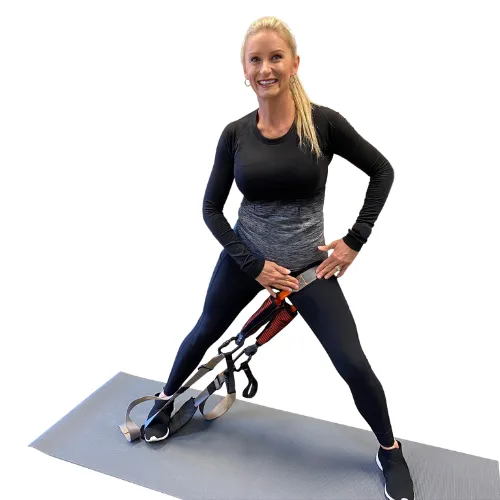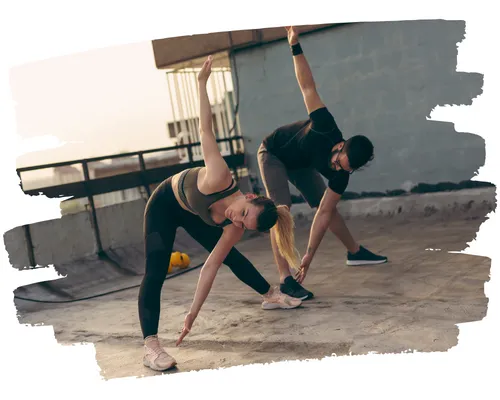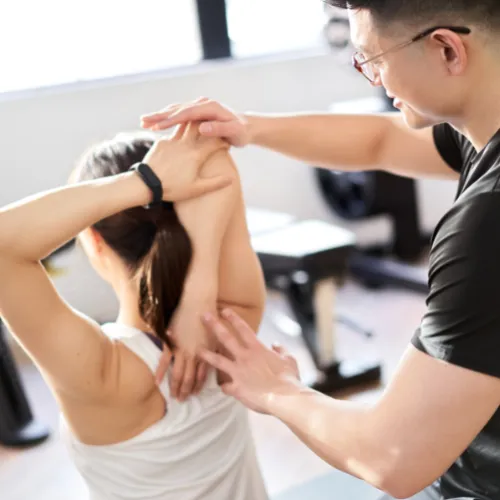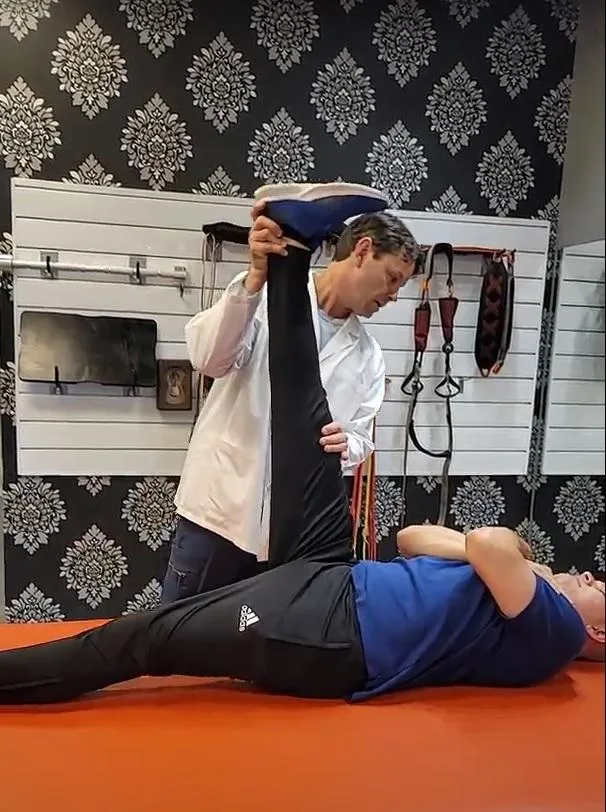Services > Stretching
Stretching
Stretching is a form of physical exercise that involves elongating the muscles to promote relaxation, improve range of motion, and reduce pain. It can be done before and after physical activity, as well as on its own.
At Chiro & Stretch we believe that stretching on a regular basis can help increase blood flow to the muscles, which in turn helps to optimize their performance during physical activity. It also helps to improve flexibility and balance, reduce tension throughout the body, alleviate stress, and prepare the body for the upcoming activity or just keep the body moving easier with less stress.
Types of Stretching Offered:
Static stretching which is one of the most common forms of stretching used today. With this type of stretching, you stretch a muscle until a slight discomfort or tension is felt and hold it there for 10-30 seconds. As you hold the stretch your body will relax more fully into it as time passes.
Dynamic stretching involves controlled movements through a full range of motion (ROM) while slowly increasing intensity at each point along the ROM. This type of stretching is typically used to warm up prior to physical activity but may also be used after activity or even when engaging in low intensity activities such as walking or yoga.

What is Stretching?
Stretching is a type of physical activity that is designed to lengthen the muscles and improve flexibility. It can be performed statically (holding a stretch for a period of time) or dynamically (moving through a range of motion). Stretching can be beneficial for both active individuals (e.g., athletes) and sedentary individuals (e.g., office workers).
Stretching is an important part of any fitness routine. It helps to improve range of motion, flexibility, and can also help to prevent injuries. Stretching can be done before or after exercise, and there are a variety of stretches that can be performed depending on your goals. Static stretches are those where you hold a position for an extended period of time, while dynamic stretches involve moving through a range of motion.

Benefits of Stretching
It prevents everyday aches and pains: Those who lead sedentary lifestyles may experience minor aches and pains or limited movement in certain muscles. This discomfort is attributable to tension and strain in the muscles caused by sitting too much whether at a desk or on a couch. Consistent stretching, if done correctly, can help to resolve this tension and diminish or even eliminate these aches and pains entirely. It’s one of the most effective ways to loosen tight muscles and alleviate various types of pain, including neck pain, back pain, and joint pain.
It helps your muscles heal: Stretching helps your muscles heal whether they need healing from stress and misalignment caused by strenuous exercise or as the result of spending long hours hunched over a laptop.
It can help you reduce stress: Stretching is very relaxing - especially when it includes a breathing component that connects the breath to the movement as in the practice of yoga.
Services > Stretching

Stretching
Stretching is a form of physical exercise that involves elongating the muscles to promote relaxation, improve range of motion, and reduce pain. It can be done before and after physical activity, as well as on its own.
At Chiro & Stretch we believe that stretching can help increase blood flow to the muscles, which in turn helps to optimize their performance during physical activity. It also helps to improve flexibility and balance, reduce tension throughout the body, alleviate stress, and prepare the body for the upcoming activity.
Types of Stretching Services Offered:
Static stretching which is one of the most common forms of stretching used today. With this type of stretching, you stretch a muscle until a slight discomfort or tension is felt and hold it there for 10-30 seconds. As you hold the stretch your body will relax more fully into it as time passes.
Dynamic stretching involves controlled movements through a full range of motion (ROM) while slowly increasing intensity at each point along the ROM. This type of stretching is typically used to warm up prior to physical activity but may also be used after activity or even when engaging in low intensity activities such as walking or yoga.
What is Stretching?
Stretching is a type of physical activity that is designed to lengthen the muscles and improve flexibility. It can be performed statically (holding a stretch for a period of time) or dynamically (moving through a range of motion). Stretching can be beneficial for both active individuals (e.g., athletes) and sedentary individuals (e.g., office workers).
Stretching is an important part of any fitness routine. It helps to improve range of motion, flexibility, and can also help to prevent injuries. Stretching can be done before or after exercise, and there are a variety of stretches that can be performed depending on your goals. Static stretches are those where you hold a position for an extended period of time, while dynamic stretches involve moving through a range of motion.
Benefits of Stretching

It prevents everyday aches and pains:
Those who lead sedentary lifestyles may experience minor aches and pains or limited movement in certain muscles. This discomfort is attributable to tension and strain in the muscles caused by sitting too much whether at a desk or on a couch. Consistent stretching, if done correctly, can help to resolve this tension and diminish or even eliminate these aches and pains entirely. It’s one of the most effective ways to loosen tight muscles and alleviate various types of pain, including neck pain, back pain, and joint pain.
It helps your muscles heal:
Stretching helps your muscles heal whether they need healing from stress and misalignment caused by strenuous exercise or as the result of spending long hours hunched over a laptop.
It can help you reduce stress:
Stretching is very relaxing - especially when it includes a breathing component that connects the breath to the movement as in the practice of yoga.
Stretching Easy as 1-2-3

Schedule Appointment

Fill out Forms & Meet Doctor

Get Treatment
Stretching Easy as 1-2-3



Schedule Appointment
Fill out Forms & Meet with Doctor
Get Your Treatment
The 3-Step Process For
Stretching

Step 1: Schedule Your Appointment
Call, Click or Tap Schedule Appointment button and fill out Contact Form to schedule your first visit. A staff member will call you as soon as possible and get you in the books.

Step 2: Arrive at our Center & Fill out Paperwork or Bring it with you
Arrive 10-15 minutes to fill out the New Patient Forms or download/fill them out and bring with you. You can download them here or in the Menu bar.



Step 3: Get Your Treatments
Meet with doctor to discuss your symptoms and recommendations and then get your treatment.
3-Step Process For
Stretching
Step 1: Schedule Your Appointment

Call, Click or Tap Schedule Appointment button and fill out Contact Form to schedule your first visit. A staff member will call you as soon as possible and get you in the books.

Step 2: Arrive at our Center & Fill out Paperwork or Bring it with you

Arrive 10-15 minutes to fill out the New Patient Forms or download/fill them out and bring with you. You can download them here or in the Menu bar.

Step 3: Get Your Treatments

Meet with doctor to discuss your symptoms and recommendations and then get your treatment.
Stretching FAQ's
Frequently Asked Questions About Stretching
Q: Why is stretching important?
A: Stretching is important because it helps improve flexibility, range of motion, and circulation, while also reducing the risk of injury. Stretching can also help reduce stress and tension in the muscles, which can improve posture, balance, and overall physical performance.
Q: How long should I stretch for?
A: The amount of time you should spend stretching depends on your individual needs and goals. As a general rule, it's recommended to hold each stretch for 10-30 seconds, and repeat each stretch 2-4 times. However, longer or shorter stretches may be necessary depending on your fitness level and flexibility.
Q: When is the best time to stretch?
A: The best time to stretch is when your muscles are warm and pliable, such as after a workout or a hot shower. Avoid stretching cold muscles, as this can increase the risk of injury. If you're stretching before exercise, start with a light warm-up to get your blood flowing and your muscles warmed up.
Q: What are the different types of stretching?
A: There are several different types of stretching, including static stretching, dynamic stretching, PNF stretching, and ballistic stretching. Static stretching involves holding a stretch for a period of time, while dynamic stretching involves moving through a range of motion repeatedly. PNF stretching involves contracting and relaxing the muscles while stretching, while ballistic stretching involves bouncing or jerking movements to stretch the muscles.
Q: How can I improve my flexibility?
A: To improve flexibility, it's important to stretch regularly and gradually increase the intensity and duration of your stretches over time. Incorporating yoga or Pilates into your fitness routine can also help improve flexibility, as can using foam rollers or other stretching tools. It's important to listen to your body and not push yourself too hard, as overstretching can lead to injury.
Contact Us
Hours
Social Media
Monday - Friday: 10:00 AM - 7:00 PM
Saturday: By appointment only
Sunday: Closed
Stretching FAQ's
Frequently Asked Questions About Stretching
Q: Why is stretching important?
A: Stretching is important because it helps improve flexibility, range of motion, and circulation, while also reducing the risk of injury. Stretching can also help reduce stress and tension in the muscles, which can improve posture, balance, and overall physical performance.
Q: How long should I stretch for?
A: The amount of time you should spend stretching depends on your individual needs and goals. As a general rule, it's recommended to hold each stretch for 10-30 seconds, and repeat each stretch 2-4 times. However, longer or shorter stretches may be necessary depending on your fitness level and flexibility.
Q: When is the best time to stretch?
A: The best time to stretch is when your muscles are warm and pliable, such as after a workout or a hot shower. Avoid stretching cold muscles, as this can increase the risk of injury. If you're stretching before exercise, start with a light warm-up to get your blood flowing and your muscles warmed up.
Q: What are the different types of stretching?
A: There are several different types of stretching, including static stretching, dynamic stretching, PNF stretching, and ballistic stretching. Static stretching involves holding a stretch for a period of time, while dynamic stretching involves moving through a range of motion repeatedly. PNF stretching involves contracting and relaxing the muscles while stretching, while ballistic stretching involves bouncing or jerking movements to stretch the muscles.
Q: How can I improve my flexibility?
A: To improve flexibility, it's important to stretch regularly and gradually increase the intensity and duration of your stretches over time. Incorporating yoga or Pilates into your fitness routine can also help improve flexibility, as can using foam rollers or other stretching tools. It's important to listen to your body and not push yourself too hard, as overstretching can lead to injury.
Contact Us
(239) 977-5353
Hours
Monday - Friday: 10:00 AM - 7:00 PM
Saturday: By appointment only
Sunday: Closed
Social Media













